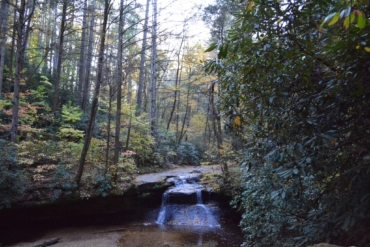A stunning, short alternative to the popular Annapurna Base Camp (ABC) or Everest Base Camp treks, Mardi Himal is a 5-day journey in a quiet corner of Nepal’s Dhaulagiri region.
While this “Hidden Treasure” trail, through the winding ridge between the Mardi Khola and Modi Khola valleys, presents one big jungle climb, your uphill efforts won’t go to waste.
Along the Mardi Himal route, you’ll encounter charming little villages — home to the warm and friendly Gurung people who have their own language and calendar. They live amid long-tailed langurs in the dense cloud forests, where yaks, deer, and blue sheep graze near terraced farms.
While we embarked on the hike in October 2022, arguably there’s merit to trekking this trail at any time (save Monsoon). Every season offers something delightful: the green wilderness of Springtime, the beautiful weather and flowering rhododendrons in the fall, or the unfettered snowscapes and golden light of winter.
Take your pick! Here’s all you need to know to embark on a Mardi Himal trek of your own.
Trekking to Mardi Himal, Nepal: A How-To Guide
Passing by the eco-friendly homestays — 10 a penny on the trail — you may wish to linger or change your adventure plans. It’s no big deal if you feel like calling it a day sooner than planned.
You are surrounded by world-class vistas courtesy of Himalayan majesty. Plus, the maximum altitude isn’t too severe, so acclimatization is easy enough to acquire.
The sacred Machhapuchre Mountain, in particular, is allegedly the home of Shiva — the Hindu god. Thus, it is banned from climbing but is all the more breathtaking.
The up-and-back trek was opened to the public a decade ago and has remained inexpensive compared to other Nepali hikes. The shorter-term duration of this still-undiscovered hike will reward you handsomely. Here’s how.
Quick Facts on Mardi Himal

- Elevation: 5,807 ft. to 14,927 ft.
- Hiking season: October to November and March through May
- Minimum group size: One. (If solo trekking, consider pre-acclimatizing on the Poon Hill, Annapurna Panorama, or ABC treks.)
- Transportation: Take a taxi or an hour’s bus ride from Baglang Bus Park, Pokhara
- Starting point: Kande (Ghandruk or Landruk); Finishing point: Kande (Siding or Landruk)
- Trek duration: Five days and 32 miles.
Grading of Hike
Moderately challenging. While it’s a straightforward up-and-down trek, you’ll be making a 9,120-foot elevation gain on a well-trodden trail up to 14,927 feet, so it will require effort.
The nigh constant ascent is worth the footslog when you exit the forest; looking out on the Annapurna Mountain Range is a head-in-the-clouds beauty that will bowl you over.
Good to Know

- Signs and markers guide the trail; coupled with the offline trail app, Maps.me, you can’t get lost.
- If you’re fit, condense the trek to 3 days and 25 miles by altering the start and finish points
- Hit the trail by 8 a.m. to finish well before the light at dusk becomes magical.
- You can climb to MBC on a sunset hike to avoid a 4 a.m. start, trekking the last hour in darkness.
- During the summer and fall, carry salt to rid those pesky leeches from you in the jungle sections.
- Give the territorial dzos (yak/cow inter-breeds) a wide berth on the trail; some are prone to shunting trekkers, as Jason learned the hard way!
Visas and Permits
- An on-arrival tourist visa when crossing a land border into Nepal for 15 days is $30, 30 days is $50, and 90 days is $125. Or, apply online in advance. Bring in unmarked, brand-new U.S. dollar bills for a visa and trekking permits (Nepalese Rupees are not accepted, nor are creased bills).
- An ACAP (Annapurna Conservation Area Permit) costs $23, and a TIMS (Trekkers Information Management System) card is $20. Complete an application form with copies of your travel insurance, four passport photos, Covid vaccinations, and passport. Submit it to the Department of Immigration via the Tourism Information Center or a trekking agency in Kathmandu or Pokhara.
5-Day Trek Itinerary
Author’s note: Distances and timings below are approximate.
Day 1: Kande to Dod Kharka
Est. time & distance: 5 hours, 7.5 miles, and 8,366 feet

From the trailhead at Kande, the trek climbs through the jungle on narrow paths in the leech-loving lower foothills of the Annapurnas.
You will be bestowed at your first lodge in a forest clearing with arresting, albeit distant views of Machhapuchhre, otherwise known as Fishtail Mountain.
Day 2: Dod Kharka to Low Camp
Est. time & distance: 5 hours, 7.5 miles, and 8,366 feet
Hike up to the junction, which turns off the ABC trail. Trek through a dense forest of hemlock, maple, oak, blossoming rhododendron bushes (season dependent), and blue pines.
The path to Low Camp meanders through the jungle, covered with lichen, moss, and tree ferns. As you climb, you’ll see bamboo. Another impacting view of Machhapuchhre awaits!
Day 3: Low Camp to High Camp
Est. time & distance: 4 hours, 2.5 miles, and 11,647 feet

Around an hour above Low Camp and the juniper shrubs, the path breaks above the tree line at 9,842 feet.
Take a moment to savor the openness. Over to the West, there’s a corking view of Annapurna South and Hiunchuli. Continue along the Mardi Himal ridge, and if you’re lucky, feast your eyes on the Monal butterflies, colorful Danphe (Nepal’s national bird), and Kalij pheasants before reaching High Camp.
Day 4: a) High Camp to Mardi Himal Base Camp / b) High Camp to Forest Camp
Est. time & distance: a) 4 to 5 hours, 3 miles, and 14,928 feet) / b) 6 hours, 5 miles, and 8,530 feet

Today’s the 4 a.m. early-bird-catches-the-worm start. After consuming anything you can stomach at that time, ascend 3,280 feet on the ridge toward Mardi Himal.
It’s a trail of steep sections on rock, passing herders’ huts along the way. You may need to pick your way through flocks of sheep and herds of goats lying on the stone steps.
Post sunrise, and in about 3 hours, you’ll reach Upper View Point at 13,780 feet. Cue the panoramic vistas of the Annapurna Sanctuary: south-facing of Annapurna, Fishtail, and Hiunchuli.
Lunch at Mardi Base Camp, replenish provisions at High Camp, and descend to Forest Camp.
Day 5: Forest Camp to Kande (5 to 6 hours, 8.7 miles, and 5,807 feet)
In this case, what goes up must come down. From whence you came will get you back to Kande.
Topography and Climate

The altitude of this itinerary rises from 5,807 feet to 14,927 feet above sea level. Visible in the upper third of the hike, you will pass close to the mountains of the Himalayas, which range from 21,130 to 26,545 feet!
The mountainous composition includes Annapurna South, Annapurna I, II, III, and IV, Hiunchuli, Glacier Dome, Singu Chuli, Gangapurna, Machhapuchhre, Lamjung, Manaslu, Nagdhi Chuli, Himalchuli, and Bouddha. It’s up there with the best short treks in Nepal!
Spring

As Nepal’s “greenery season,” March through May is optimal.
The forested area’s flora and fauna take on a newfound wonder at this time, where daytime temperatures hover around 68 degrees by day, and 37 at night. Crystal clear skies are bluebird blue, enhancing the splendor of the mountains.
The number of trekking will be significantly less. April and May (and September to October) will be hot and humid at lower elevations; don the sun hat and sunscreen, and stay well-hydrated.
Monsoon
Monsoon season spans June to August in Nepal, where pleasant skies prevail. That is, when there’s no deluge leaving the trail slippery and the visibility socked-in with fog.
Refreshingly, the downpours clear the humidity, a breath of fresh air at around 62 to 68 degrees. The first and last thing you’ll see is 41 to 50 degrees. Decent rain gear and waterproof boots are must-haves during the summertime.
Fall
Autumn is known as the “king of all seasons,” due to the trending, post-monsoon season that attracts trekkers by the busload.
Warm, clear days give rise to flowering rhododendrons and oak trees from September through November. Average temperatures stay around 62 to 68, cooling somewhat as you climb.
Winter

The off-season starts in December. No sign of humidity; it’s dry in winter.
Thick, untouched snow blankets the pristine mountains, making the trail treacherous and sloppy. The cold air is a nippy 48 to 53 degrees, nosediving to 23 at night and first thing.
Taking your microspikes, as well as a guide or porter, could be a good call. Terrifically, trekkers on the trail will be few and far between.
Food and Accommodation

Although you will lunch en route at another teahouse, it’s the norm to dine for your evening meal in the guesthouse where you’re overnighting.
The cuisine will be Nepalese, Indian, Chinese, and Western — the menus are practically the same throughout the trek. Typically, breakfast will be chapatti, Tibetan bread, muesli, eggs, or oatmeal.
Dal Bhat is abundant — dal (lentils), vegetable curry, and rice with free refills. Spicy buffalo meat is also available, where local produce is grown organically.

It can get crowded during peak season, so it might be worth investing in a Nepalese SIM card to prebook your bed.
The “teahouses” are rustic and basic (bring your own sleeping bag), becoming increasingly expensive the higher you go. They charge for electricity, so taking a solar-power charging device or an external power bank will keep you in business. Twin rooms with shared showers range from $5 to $12.
Note there will be fewer accommodation options during the off-season. You will be charged extra for electricity, Wi-Fi, and a hot shower; these facilities cease at higher elevations.
Valuable Tips for Visiting Mardi Himal

- Pick a good weather window before setting off.
- Hire a porter ($25 per day) if you’d rather manage a daypack. The less weight you haul, the more enjoyable the experience, especially at higher elevations.
- Go slow, stay hydrated, and stop regularly. If you suffer any Acute Mountain Sickness symptoms, descend and rest.
Mardi Himal Packing List
| Essential | Don’t Forget | Nice-to-Have |
| Backpack with anti-gravity back system | Solar panel charging device and, or an external power bank | Packing cubes |
| First-aid kit: altitude sickness tablets, Compeed (blister second skins), electrolytes, cold and flu capsules, and diarrhea tablets | SteriPEN Ultra (USB chargeable) and a filter, a LifeStraw, water bottle/hydration bladder, Water-to-Go, Squeeze Water Filtration System, or water purifying tablets | Lightweight combination padlock for your room |
| Warm down jacket | Maps.me app — offline trail map | Compression waterproof sacks |
| Waterproofs (breathable) | Camera | Earplugs |
| Hiking pants (with vents) | Sunglasses | Wet wipes |
| Merino wool base and mid layers | Headlamp and spare batteries | Down sleeping bag |
| Trekking boots (waterproof) | Sewing-repair kit and superglue | Bandana/head BUFF |
| Quick drying towel | Gloves and underwear | Flip flops |
| Warm hat and wide-brim sun hat | Toiletries and SPF sunscreen | |
| Trekking poles | Toilet roll |









